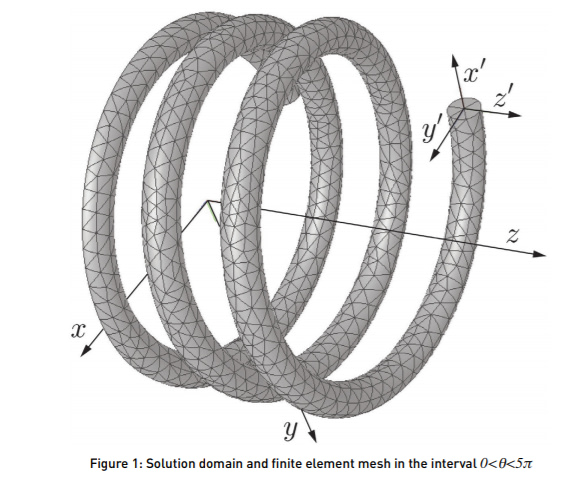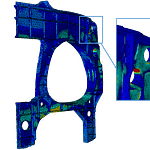Since our Simulation Technology (Sim Tech) is relatively recent, it’s important for us to address some our your frequently asked questions (FAQ’s) about the benefits, differentiators, and reasons to adopt.
Simulation Technology FAQ

Mathematical Models, Numerical Simulation, Finite Element Modeling...
Let’s first discuss fundamental engineering simulation concepts such as mathematical modeling, numerical simulation, Simulation Governance, finite element modeling, errors of approximation and more.
A mathematical model is a precise statement of an idea concerning some aspects of physical reality. Mathematical models typically comprise two or more sub-models. For example, a mathematical model formulated to predict fatigue failure of mechanical components in the high cycle range comprises (a) a mathematical problem of elasticity, (b) a predictor of failure initiation and (c) a statistical model that accounts for aleatory uncertainties.
It is a transformation (D, I) → F where D represents the available data D that characterize the physical reality we wish to simulate, I represents our understanding (idea) of how to describe that physical reality by mathematical means, and F represents the data of interest such as stress, flux density, natural frequency, etc. that we need for predicting the response of a physical system to some form of excitation.
For example, an aerospace engineer may be interested in predicting the fatigue life of a critical airframe component, such as a bulkhead. In this case D includes a detailed geometrical description of the bulkhead in the form of a CAD model, the material properties, including statistical data of the relationship between stress and the number of cycles to failure, and the design load spectra. The engineer’s experience and understanding of how to transform these data into the predicted number of cycles to failure is represented by I. The transformation involves solving a problem of elasticity to determine the location and magnitude of the maximum normal stress and one or more models of damage accumulation. The data of interest (F) are the probabilities of failure at various locations within the bulkhead, given, for example, the number of ground-air-ground cycles.
Yes. A mathematical model must be formulated so as to take into account all factors that significantly influence the data of interest F. Furthermore, the transformation (D, I) → F must be valid for all D under consideration and the formulation must be such that small changes in D will cause small changes in F. The precisely stated technical requirement is that the transformation must be continuous with respect to the input data.
Validation of a mathematical model involves comparison of predictions with the outcomes of physical experiments. A model passes the validation test if the difference between the predicted and realized outcomes can be explained by aleatory uncertainties and noise associated with the physical experiments.
The qualifier “physics-based” is superfluous. Think what an alternative would be. Would it be “metaphysics-based model”? There are various ways of describing physical reality by mathematical means at the macroscopic and microscopic levels. The formulation of a mathematical model depends on our understanding of how to represent physical reality by mathematical means and the intended use of the model.
The following statement by Wolfgang Pauli (Nobel Prize, Physics, 1945) captures the essentials remarkably well: The layman always means, when he says “reality” that he is speaking of something self-evidently known; whereas to me it seems the most important and exceedingly difficult task of our time is to work on the construction of a new idea of reality.
The assumption that the strain is small is incorporated in the model by neglecting the nonlinear terms of the strain tensor. No restriction is imposed on the size of the linear strain terms. Furthermore the stress – strain law is linear, independent of the strain. At re-entrant edges and vertices, abrupt changes in boundary conditions and material properties, the strain can become infinitely large. Of course, this is physically impossible. All mathematical models are based on certain assumptions that analysts must clearly understand and consider in interpreting the data based on models. Mathematical models should never be confused with the physical reality they are supposed to represent.
Simulation is the imitative representation of the functioning of one system or process by the functioning of another. In numerical simulation the functioning of a system or process is represented by a mathematical model which is solved by numerical means.
Because mathematical models used in engineering practice tend to be very complicated, the best one can do is to approximate the data of interest F by numerical means. The numerical approximation to F is denoted by Fnum.

For additional details and references please refer to Selected References.
At its 2017 World Congress NAFEMS, the International Association for Engineering Modelling, Analysis and Simulation, identified eight “big issues” in numerical simulation. The top three were:
- Simulation Governance – What it takes for organizations to develop confidence in the results of their numerical simulation projects.
- Democratization – How to extend the benefits of numerical simulation to persons whose expertise is in other fields
- Certification – How to convince others that the results of numerical simulation can be trusted.
Simulation governance is the exercise of command and control over all aspects of simulation. For details please refer to B. Szabó and R. Actis. Simulation governance: Technical requirements for mechanical design. Computer Methods in Applied Mechanics and Engineering. Vol. 249-252, pp. 158 – 168, 2012.
Learn more in our Simulation Governance page.
Finite element models are intuitively constructed numerical problems the solutions of which are expected to represent the response of a physical system or process to some form of excitation. The numerical problem is constructed by assembling elements from a finite element library. A finite element model may or may not correspond to a well-posed mathematical problem and therefore progressive mesh refinement may or may not converge to a limiting solution.
Although the term “finite element model” is frequently used, this term confuses rather than enlightens. This is because it mixes two fundamentally different entities: The mathematical model and the method (specifically the finite element method) used for approximating the solution of the mathematical model. Please refer to ESRD’s technical brief entitled “Why Finite Element Modeling is NOT Numerical Simulation?” as well as “Notes on Finite Element Modeling“.
No. The equilibrium of nodal forces has nothing to do with the finite element solution. The nodal forces will be always in equilibrium even if the error of approximation is very large. A detailed explanation is available in Szabó B. and Babuška, I. Introduction to Finite Element Analysis: Formulation, Verification and Validation. John Wiley & Sons Ltd. 2011, Section 7.2.
Virtual experimentation is a process by which the sensitivity of the data of interest with respect to assumptions incorporated in a mathematical model is tested.
For example, in linear elasticity a linear relationship is assumed to exist between stress and strain and the equations of equilibrium are written with respect to undeformed configuration, implying the assumption that the difference between the deformed and undeformed configurations is negligible. These assumptions are justifiable only under certain conditions. Analysts need to verify that the solution of a mathematical model is consistent with the underlying assumptions.
For instance, if the mathematical model is based on small-strain and small-deformation theory of elasticity then the deformed configuration plotted on 1:1 scale should be almost indistinguishable from the undeformed configuration. If the difference is substantial then a mathematical model based on large-deformation should be used. Should the equivalent stress (von Mises stress) exceed the yield stress, it will be necessary to solve a nonlinear problem taking plastic deformation into account. This raises additional questions such as which model of plasticity should be used? How sensitive are the data of interest to the choice of plasticity models and the parameters that characterize plastic deformation? These questions can be answered through virtual experimentation.
The hierarchic modeling framework implemented in StressCheck was designed to support virtual experimentation.
Solution of a mathematical problem by numerical means involves some form of discretization. For example, in the finite difference method a grid has to be defined. In the finite element method a mesh and basis functions associated with the elements of the mesh are defined. The numerical solution depends of the discretization. The difference between the numerical solution and the exact solution of the mathematical problem measured in some norm is the error of discretization. In engineering calculations the estimated errors of discretization should be stated as (estimated) relative errors in the quantities of interest.
The errors of discretization can be reliably estimated by various methods that do not require knowledge of the exact solution. Estimation of the errors of discretization is an essential technical requirement in numerical simulation. It is not sufficient to report an approximate value without an estimate of how large the error of approximation is.
Suppose that you are a strength engineer in an aerospace company. Someone suggests that since you do not know the service loads accurately, you should not worry about the accuracy of the numerical solution obtained by the finite element method. How would you respond?
It is true that service loads acting on an airframe are not known accurately. However, as a strength engineer you were given the task to consider very precisely defined static and dynamic loads, prescribed by the certification criteria to determine margins of safety. Therefore you know the loads that the airframe is expected to resist very accurately. Since your assignment is to satisfy criteria for certification, you need not worry about uncertainties in the service loads. However you must provide evidence that the error of approximation is within acceptable tolerances.
No. The term validation, as used in numerical simulation, refers to validation of mathematical models with respect to their predictive performance. A finite element code can and should be verified to show that it correctly performs certain specific operations.
ESRD's Numerical Simulation Technology...
Below, we pose and answer FAQ’s related to ESRD’s numerical simulation technology and StressCheck, which implements the p-version of the finite element method and adheres to the strict standards of Simulation Governance.
From Wikipedia:
 , approaches infinity. This is in contrast with the “h-version” or “h-FEM”, a widely used discretization strategy, in which the polynomial degrees of elements are fixed and the mesh is refined such that the diameter of the largest element, denoted by
, approaches infinity. This is in contrast with the “h-version” or “h-FEM”, a widely used discretization strategy, in which the polynomial degrees of elements are fixed and the mesh is refined such that the diameter of the largest element, denoted by  approaches zero.
approaches zero.
It was demonstrated on the basis of a linear elastic fracture mechanics problem that sequences of finite element solutions based on the p-version converge faster than sequences based on the h-version by Szabó and Mehta in 1978.[1] The theoretical foundations of the p-version were established in a paper published Babuška, Szabó and Katz in 1981[2] where it was shown that for a large class of problems the asymptotic rate of convergence of the p-version in energy norm is at least twice that of the h-version, assuming that quasi-uniform meshes are used. Additional computational results and evidence of faster convergence of the p-version were presented by Babuška and Szabó in 1982.[3]
The distinction between the h- and p-versions exists primarily for historical and theoretical reasons. In practical applications the design of the mesh and the choice polynomial degrees are both important. In fact, it is possible to realize exponential rates of convergence when the p-version is used in combination with proper mesh design. This point was discussed from the engineering perspective by Szabó and from the theoretical perspective by Guo and Babuška in 1986.[4][5] Realization of exponential rates of convergence for Maxwell equations was discussed by Costabel, Dauge and Schwab in 2005[6]
The finite element method (FEM) provides an approximate solution. In engineering practice it is important to know not only the information one wishes to compute but also to have an indication about the size of error of FEM approximation. The p-version FEM makes it convenient and efficient to obtain error estimates in terms of the data of interest.
Research on the p-version dates back to the late 1960’s. Many important advances occurred in the 1970’s. The theoretical basis of the p-version was established in 1981 and optimal meshing strategies appropriate for the p-version were developed in the period 1984-1985. For details, refer to B. Szabó and I. Babuška. Finite Element Analysis. John Wiley & Sons, Inc. (1991). Beginning in 1985, these developments were made available for use in professional practice. The p-version FEM is a more recent technology than the h-version, the development of which began in the late 1950’s.
Yes. For typical design problems in mechanical, aerospace and structural engineering practice the errors of approximation are reduced at an exponential rate when the number of degrees of freedom are increased, provided that the finite element mesh is properly constructed. The h-version can provide algebraic convergence rates only. This makes error control much more effective in the p-version. Furthermore, a converging sequence of solutions is much more naturally and conveniently obtained with the p-version than with the h-version. This makes it feasible to employ quality control procedures in the setting of practical engineering decision-making processes.
StressCheck is the only FEA code that meets the technical requirements for simulation governance. Specifically, StressCheck supports (a) solution verification which is essential for the control of the errors of approximation in terms of the data of interest and (b) control of the errors of idealization through access to a hierarchic sequence of mathematical models. In addition, StressCheck provides vastly superior post-processing capabilities as well as unique technical capabilities in strength, durability, and damage tolerance of metallic and composite structural and mechanical components.
Is StressCheck the Right FEA Tool for Me?
ESRD continues to develop & implement powerful features in support of engineers performing detailed stress, strength, damage tolerance, fracture, laminated composites, residual stress, and other analyses requiring high-fidelity FEA simulations.
Looking for Resources?
Recent News & Events
Quick Links
Testimonials
-
“An advanced modeling and analysis tool for complex composite structures is generating benefits across the aerospace industrial base. StressCheck [Composites] is widely viewed as the next-generation composite joint strength tool.”
Air Force Research Laboratory (AFRL)
 Serving the Numerical Simulation community since 1989
Serving the Numerical Simulation community since 1989 






